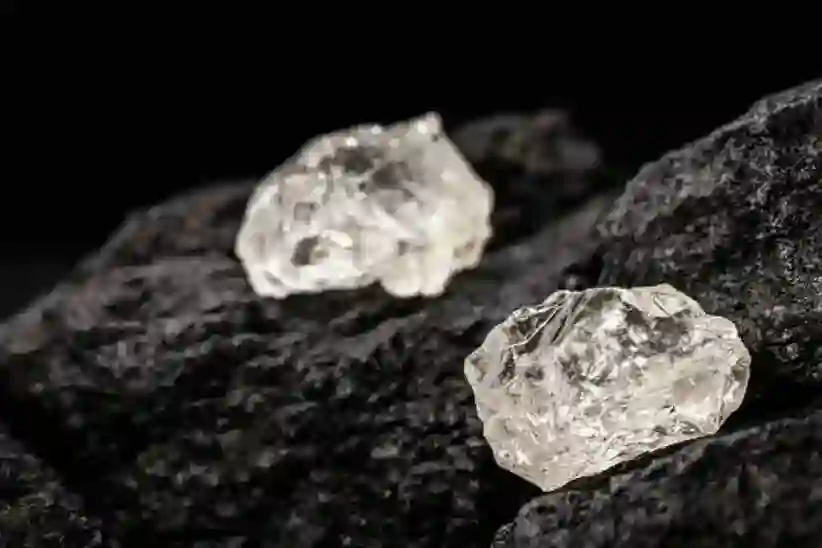Researchers have unveiled a breathtaking spectacle: the Earth’s core holds a treasure trove of diamonds that erupt to the surface in spectacular, explosive volcanic displays called Kimberlites eruption. This captivating revelation paints a picture of geological marvels, but the question remains – what causes these fountains of diamonds to ascend from the very heart of our world?

These Kimberlites eruptions don’t just happen anywhere; they prefer the heart of continents, where the crust is robust and unyielding. (Photo: VN Explorer)
Kimberlites Eruption
Kimberlites eruptions, similar to nature’s fireworks, can propel diamonds at speeds ranging from 11 to 83 mph (18 to 133 km/h) often rivaling the destructive force of a Mount Vesuvius-like explosion.
These precious gems have an enigmatic origin, forming in the Earth’s crust, buried a staggering 93 miles (150 kilometers) beneath the surface. What’s even more astonishing is the incredible speed at which they make their ascent. These subterranean marvels are catapulted to the surface in a geological phenomenon known as kimberlites eruption, a published article reported.
Thomas Gernon, a distinguished professor of Earth and climate science at the University of Southampton in England, has been at the forefront of unraveling this geological spectacle of kimberlites eruption. He, along with his team, has uncovered a tantalizing connection between the breakup of supercontinents and the breathtaking Kimberlites eruption.
These Kimberlites eruptions don’t just happen anywhere; they prefer the heart of continents, where the crust is robust and unyielding.
North America’s history is no less enchanting, with kimberlites eruption surging forth as Pangaea began its slow drift apart, some 250 million years in the past. Remarkably, these eruptions seemed to commence at the fringes of these colossal continental fractures before elegantly marching toward their core.
READ ALSO: SpaceX’s Falcon 9 Successfully Delivers 22 Starlink Satellites to Orbit
What Causes Kimberlites Eruption?
So, what directs this mesmerizing spectacle deep within the Earth’s crust? The answer lies in the intricate ballet of the planet’s inner layers, where tectonic plates perform a delicate dance of two, Live Science reported.
As these colossal slabs part ways, the base of the continental crust gracefully thins, mirroring the surface’s gentle formation of valleys. In this tumultuous tango, molten rock ascends mingling with the disrupted boundaries, only to cool and sink again giving birth to localized circulatory patterns.
These volatile regions set in motion a domino effect, destabilizing their neighbors and commencing a slow but inexorable migration toward the continent’s heart. This revelation mirrors the ballet of kimberlite eruptions, starting at rift zones and gracefully waltzing their way into continental interiors.
But how does this geologic dance of two lead to the explosive Kimberlites eruption from deep within the Earth’s crust? The secret lies in the harmonious blending of specific materials. These instabilities create a waltz between rocks from the upper mantle and lower crust, with a dash of water, carbon dioxide, and the essential ingredients of kimberlite minerals, including the coveted diamonds.
The result is akin to a champagne bottle vigorously shaken, generating eruptions brimming with explosive potential and an inherent buoyancy that propels them toward the surface. It’s a dazzling spectacle that leaves geologists and gem enthusiasts alike in awe.
In the end, the story of Earth’s erupting diamonds is a testament to the mesmerizing complexity and beauty that lies beneath our feet, a reminder that even the most dazzling secrets of our world can be unlocked through the patient study of nature’s grand design.




![Tyson Foods Plant [Photo: Food Manufacturing]](https://southarkansassun.com/wp-content/uploads/2023/08/iStock_1185520857__1_.5e441daa51cca-600x337.jpg)







![Silverado Senior Living Management Inc. [Photo: Los Angeles Times]](https://southarkansassun.com/wp-content/uploads/2023/10/download-6-4-600x337.jpg)

![China's Wuhan Institute of Virology [Photo: Nature]](https://southarkansassun.com/wp-content/uploads/2023/09/d41586-021-01529-3_19239608-600x337.jpg)
















